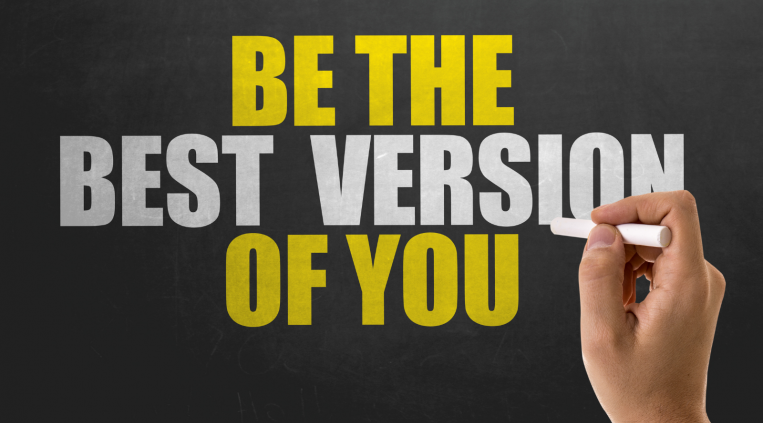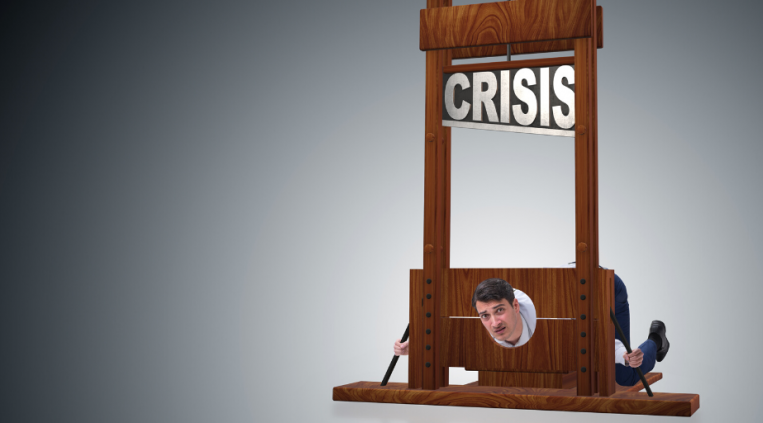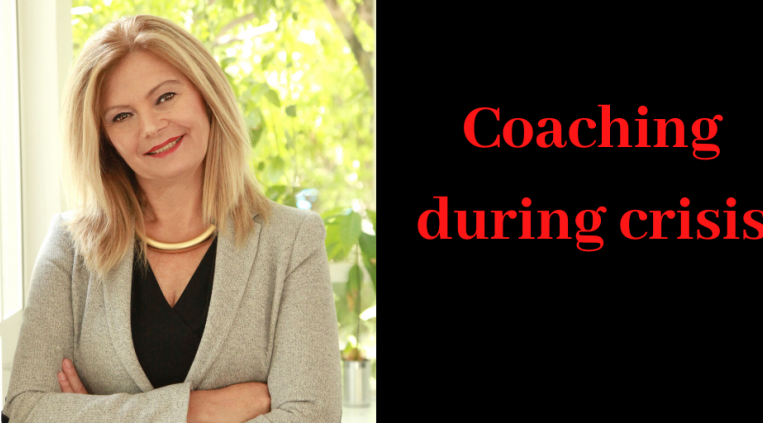
The best version of yourself? This is the time to begin your journey.

1. Be yourself. One of the most popular (and worst) pieces of management advice is to find a role model to imitate. This advice works against you from day one. Instead of acknowledging your unique abilities and talents, using a role model re-shifts your focus on what you don’t have. Instead, it is far more productive to concentrate on your positive points, as this will strengthen you and fuel your motivation. More importantly, you invest your energies in building up yourself as a success.
2. Differentiate yourself from others. Find out what’s special about you and make it prominent, so that decision makers will recognize how to differentiate between you and others. This will become your relative advantage, or your USP (unique selling proposition), just as in marketing. And like in marketing, you’ll need to manage your brand, ensuring that it always stands for something that others don’t have.
3. Say no to cookie-cutter solutions. As a unique brand, you should shy away from catch-all formulas for success. So save your valuable time and money by avoiding all kinds of general classes, seminars and workshops. These are the places that will stamp out your uniqueness, rather than provide an opportunity to let it flourish.
I’ve put together a 6-hour power course to help you get the promotion you deserve. My GIFT to you. No sales. No marketing. for FREE . Get started today.
https://bit.ly/3g3ciDP
Enjoy : )
And always remember:
Great managers are made. Not born.
https://myexecutivemirror.com/
get your weekly free blog update
Why is it so hard for us to hire top performers?

It seems like hiring top performers has gotten almost impossibly challenging. No doubt, the furious pace of global business is a big contributor, with demand for top performers climbing all of the time.
But the truth is that hiring top performers has always been one of HR’s most difficult challenges. It’s something I struggled with when I began my own career over three decades ago.
When the difficulty of hiring top performers first came up in my career, I made a list of possible reasons:
- Headhunters aren’t doing their job.
- Organizations can’t offer enough money.
- Role descriptions aren’t accurate.
- Role/industry/company image/location aren’t attractive.
- Ego issues (on both sides)
- “Old school” hiring practices
While these were good hunches, I knew that I needed to check with the field. As I was lucky enough to have working relationships with many of the top HR industry leaders, I asked them why they thought hiring top performer was so challenging. After analyzing all of their answers, I boiled them down to four main points:
1. Incompetent headhunters
2. Differences in compensation expectations
3. Inflated egos making unrealistic demands
4. Unattractiveness of industry/organization/location
This was from the HR perspective, but what about the top performers themselves? Again, as I had access to many top performers (I had “raised” most of them), I asked them the same question from their perspective: Why did you turn down your latest job offer?
This time, I received a much wider range of answers, but here are the top four (in descending order):
1. Organizational culture
2. Intraorganizational mobility
3. Compensation package
4. Hiring process
When I analyzed the data, I was surprised to see that compensation was listed as third. According to the HR professionals, they were missing out on top performers because of money. But according to the performers themselves, this clearly wasn’t the case. The number one reason was organizational culture. What was I missing?
To answer this, I needed to somehow bridge the perspectives of HR and the top performers themselves.
So I went back to the top performers to ask them what they think organizations see as their biggest challenge in hiring them. I got three answers:
- Incompetent headhunters
- Compensation demands
- Top performer’s ego
Clearly, the top performers were able to put themselves in the shoes of the organization - so much that unless the organizations were told that their culture was the number one culprit, recruiting top performers would remain elusive forever.
So it was now time to focus on organizational culture. As it’s such a catch-all term, I returned to the top performers to ask what they meant by organizational culture.
From their responses, their understanding of organizational culture seemed to center on how much a top performer can develop and advance within an organization. To gauge this, they’ll ask themselves some of the following questions:
- Is the organization open enough so that new performers can really learn how it operates?
- How transparent is the organization in terms of employee promotion and turnover?
- Is leadership development a priority?
- Are there sufficient resources for this?
Following this, I understood that many organizations, when attempting to attract top performers, were making the mistake of prioritizing money over an open organizational culture that encouraged top performer growth and advancement. This, of course, with work, can be changed.
From my perspective, every organization has the potential to hire top performers. They just need to make the choice to develop this potential.
What are your thoughts on the challenges of hiring top performers? I’d love to hear your ideas.
get your weekly free blog update
COMMENTS
Discover your hidden potential

Successful career goals for managers require that we constantly improve ourselves, whether it’s how to increase productivity, run our meetings, or manage our teams. The good news about always improving is that we end up with super skills that would require others years of experience to achieve. But surprisingly, our quest for improvement can actually prevent us from getting that next promotion.
Sounds backwards, doesn’t it? After all, we’ve been taught from an early age that improvement is one of the most important keys to standing out from the crowd.
Indeed, this is true. But consider this example. You’re a wiz at planning and running meetings. No one in your organization can do it like you, as you’ve perfected meetings to an art - from creating reader-friendly agendas and accommodating all of the participants to following up on the open issues. In fact, when someone in your organization wants to hold a high-stakes meeting, you’re the address.
Of course, you weren’t born with these meeting super skills. You’ve been perfecting them, bit by bit, for years now. And the more compliments you’ve received over the years, the more energy you’ve put into becoming the company’s resident Meeting Meister.
But let’s consider for a moment what being Meeting Meister might actually have cost you. While you were investing time perfecting l’art du meeting, were you perhaps denying other talents and skills from emerging?
For example, what about that side of you that likes to sit alone and come up with crazy ideas? When was the last time you gave yourself the time and space to just brainstorm? Or have you only allowed such ideas to come up within the framework of a well-oiled meeting?
My point here is that in pursuing improvement, sometimes we find ourselves stuck in certain managerial patterns, earning titles such as “the best at”, often at the expense of developing innate talents we’ve inadvertently muzzled.
If it were our only goal to remain, for example, the Meeting Meister, then this wouldn’t be a problem. But it is, because decision makers want to see well-rounded managers, not just specialists.
And so those managers who are simply known as “the best at…” are eventually left behind, sentenced to life in Middle Management Land.
Preventing such a life sentence requires developing your innate potential so that you can strive towards well-roundedness. I wish there were a magic formula to find out what your potential is, but alas, there isn’t.
Nevertheless, no need to despair because there is a surefire way of finding out what your potential is on your own: give it time and space. Once you let your potential out to breathe, it’ll blossom and become a natural way of shaping how you do things.
I’ll give you an example. Let’s go back to the Meeting Meister. Remember that they are good at planning meetings and making sure everyone participates. But what would happen if the Meeting Meister exercised a more “entrepreneurial spirit” and called an impromptu gathering, limiting the time people could speak? One outcome I’m familiar with is that more ideas might be generated in a shorter timeframe. And as far as the Meeting Meister is concerned, this would naturally feed into their innate talent of quick brainstorming.
So the result here is both a Meeting Meister and an entrepreneurial type of manager, all rolled into one - a much more well-rounded candidate for promotion.
Again, I can’t provide a one size fits all solution for everyone, but if you begin by reducing some of the habits that come most naturally to you, you’ll begin to discover hidden potential you’ve had all along.
Here are some key points to remember:
- Successful career goals for managers include constant improvement.
- An often neglected part of improvement is the hidden potential we’ve all got...
we just have to find it.
- Give yourself time and space to discover your hidden potential by reducing
automatic behaviors.
- A well-rounded manager always tops the promotion list.
And always remember:
Great managers are made. Not born.
get your weekly free blog update
COMMENTS
Handling crisis productively

Surf any media channel today and one word is surely to appear: “crisis”. Most people around the world agree we’re in the midst of a crisis. So we’re all good at using the word “crisis,” but have we ever really considered what a crisis is? Is it something that has suddenly been thrust upon us? Or is it fear of what might follow?
With over 35 years of experience working with leaders, I’ve had the opportunity to formulate my own interpretation of “crisis.” As opposed to what most people think, I see crisis as a fear of outcomes. If you take anything called a “crisis”, you’ll see that what’s keeping it alive and well is fear of the outcomes.
With this take on “crisis,” I release myself from the shackles of passively “waiting it out”. Instead, I act on how I can already begin dealing with the outcomes.
The managers I’ve helped over the years have been dealt big blows: denied promotions, costly failures, sudden dismissals...and the list goes on.
In most cases, when I begin my work with these leaders, most take on a passive stance: “I did everything right, and yet this has happened. I don’t know how to deal with it.”
This kind of reaction is unhelpful and will fuel the fires of crisis. Yes, leaders generally don’t bring upon unfortunate events. This is out of their control. But taking on a fatalistic mindset that nothing can be done will never help.
So at this point, I generally tell leaders that they have a choice. They can prolong the “crisis” by continuing to entertain feelings of anger, disappointment, fear, frustration, and anxiety. Or they can put the crisis aside (it’s not in their control anyway) and decide how to handle the outcomes.
While it’s hard to move past the mental hurdle of “crisis mode,” dealing with a crisis by actively addressing its outcomes will bring leaders out of crisis and back on their paths towards success.
And always remember:
Great managers are made. Not born.
get your weekly free blog update
COMMENTS
Do we really need time to get things done?

As leaders, we’ve encountered this anomaly repeatedly:
When I have little time, I get a lot done, but when I have a lot of time, I get less done.
Why is this?
The time management professionals out there can definitely answer this question from their perspective, but I’d like to offer a mindset point of view.
Briefly, the more our mind has room to handle a task, the quicker we’ll get things done. The more our mind is filled with other things, the slower we’ll get things done. So, all we need to do is to clean out our minds, right?
Well, it’s not that easy. If we cleaned out our minds totally, we wouldn’t have any resources to complete our tasks. We need positive mental energy in our minds to get things done. On the other hand, minds filled with negative mental energy keep us stuck.
So the next time you’re contemplating a task, check which of my formulas below best fits your situation.
1. Plenty of chronological time + Negative mental energy = No time (try again later)
2. Plenty of chronological time + Positive mental energy = You’ve got time (go for it now)
3. Short on chronological time + Positive mental energy = You’ve got time (go for it now)
You’ve probably noticed that based on (1) and (3), there’s no real connection between chronological time and the time we need to get things done. It’s a matter of mental energy.
So the next time you’re blaming yourself for being less productive than you should, consider your mental energy level. Is it up to task?
And always remember:
Great managers are made. Not born.
get your weekly free blog update
COMMENTS
Delivering Disappointing News During the Corona Crisis

Earlier this week, I was asked to participate in a senior management VC of one of the industry’s leading organizations. The main issue on the virtual table was how to communicate impending disappointing news (layoffs, salary reductions, etc.) to their employees.
As we all settled into the virtual conference room, one of the participants, who seemed a little agitated, spoke up:
“I might be preaching to the choir, but I really can’t stand those cliches that have been going around. You know, ‘every cloud has its silver lining,’ or ‘making lemonade out of lemons.’ Our employees deserve a heck of a lot more than that.”
I smiled and gave a big nod of approval. I took the floor.
“From my point of view, I don’t have an issue with what these kinds of sayings want to teach us. What I do have a problem with, though, is how they are used.”
“What do you mean, Etika,” another participant asked.
“Look, I am well-aware of the fact that delivering disappointing news to your employees is probably one of the most challenging and frustrating parts of being a leader. I’ve seen this played out many times, and it’s never pleasant, no matter how it’s packaged.”
I switched to gallery view on my VC software and saw all of the talking heads nod in agreement.
I continued, “But when you approach your employees with disappointing news, you have to put yourselves in their shoes first. This is definitely not the time to make things easy for yourselves. You’re the leaders here. You’re going to have to put yourselves out there so that they can feel how difficult it is for you to face them.”
I looked out at the Hollywood Squares and noticed a little confusion.
“I have a hunch that today many of you expected me to come with a written script to read to your employees, filled with wise advice, brimming with optimism towards the future - sayings such as, ‘when one door closes, another opens.’” But that’s not going to happen today.
I looked at my screen. Silence. Was my laptop frozen? No, they were in shock.
“Now, please don’t get me wrong,” I continued. “Those of you who’ve worked with me over the years know that I’m the first person to try to turn a crisis into an opportunity. However, as I said before, you have to put ourselves in your employees’ shoes. And frankly, they’re just not ready to hear about the “day after.” They are worried about tomorrow.”
“In fact,” I said, “any talk of optimism will probably backfire.”
I peered into my screen, trying my best to read the body language of the other participants. I could see they were looking for answers.
“So here’s what I think would be an effective way to approach things. First, each part of the population needs to hear a specific message for their particular situation. This will require dividing employees into groups, such as those who are facing a salary reduction and those about to be laid off. Then, these groups need to be separated again according to level, such as middle managers and line employees. You will need to hold separate meetings with each subgroup.”
I continued, “Begin each meeting by genuinely showing both how uncomfortable you are with the situation as well as the personal sacrifices you are making to keep the organization going. This will help your employees begin to connect with you, at least on a basic level. Not only will they see that you’re also affected, they’ll also understand you’re doing your best to restore things for them as quickly as possible.”
“The next stage is very important,” I emphasized. “Here, you have to demonstrate that the organization wants to help them during this time of crisis. It’ll take some planning, but for example, you could provide guidance in managing finances or mini-courses in improving professional skills. I’m sure you have the in-house talents for all kinds of offerings. Under today’s circumstances, all it takes is a laptop and goodwill.”
I conceded, “Of course, there’s no substitute for bringing back a full salary and stable job. But the feeling that the organization is trying, under these exceptional circumstances, to do what it can, will at least offer some encouragement to employees as they navigate this crisis.”
Many of the faces began to lighten up and I could sense wheels turning in the minds of most participants. They were formulating plans.
“I’ll leave you with this,” I said. “It’s crucial, especially since we can’t meet face-to-face, that our messages are both clear and sincere. This is the time, as a leader, to rise to this occasion.
And always remember:
Great managers are made. Not born.
get your weekly free blog update
COMMENTS
Coaching during crisis

As if corporate life is not tough enough, the Coronavirus has added even more stress and tension to the lives of our clients. Now, more than ever, our clients need us. Yet organizations are now watching every penny, and coaching is often one of the first expenses to be deleted from the budget. So as coaches, committed to our clients’ success, especially in the eye of the Corona storm, should we provide our services for free?
If you’ve been in the coaching business for more than ten years, you’ll probably remember the dramatic downturn following the 2008 financial crisis. And there have been other similar situations, such as the 2000 dot com bust as well. My point is that if you haven’t already, you’ll be experiencing your share of sharp dips throughout your coaching career.
What’s common to times of trouble is that, as coaches, we painfully experience the gap between the declarations of CEOs that “human capital is key to success” and the actual resources management will invest to protect their people in times of strife.
For many years, I was frustrated by this gap, especially in light of “hints” I received from big corporates to “pitch in” and provide my services pro bono. In fact, in the last few weeks, colleagues and supervisees have gotten in touch to ask for advice on this very issue. On one hand, their clients are in great need of coaching, and yet on the other hand, they face difficulty in affording coaching sessions. Then our conversations usually spiral into two key questions: “Why do my clients feel comfortable asking me to work for free when they would never even dream of engaging another professional without paying them? Why is coaching seen as different?”
My answer to the first question is related to the second one. Coaching is different. And you are perceived by your client as the only person who can help them weather the storm. People need coaching all of the time and under all circumstances, whether the market is up or down....but especially when it’s down.
Once I internalized this myself towards the beginning of my career, I simply disconnected the “logical” equation of need equals payment. When organizations tighten their belts and freeze coaching services, this doesn’t mean that our services aren’t needed. In fact, they are badly needed.
With the uncertainty brought on by the Coronavirus, my clients are getting in touch in droves. And yes, I feel it’s my duty as their coach to be there for them. Don’t get me wrong; I’m not ignoring the fact that I am providing them with my professional services without full (or any) payment. However, what I do know is that I am needed.
But I don’t have all of the answers. For example, I don’t know how many people I can help, and I don’t know how long I’ll be able to help them for. But for the time being, I’m framing the work I’m doing as “volunteering,” which I have always integrated into my life anyway. Maybe in the age of Corona, I can call it “urgent care volunteering.”
I know that with our chaotic lives and great uncertainty, volunteering might not be a viable solution. There have been periods in my career when I’ve been more limited than I am today. What I’d like for you to understand, as a fellow coach, is that you are key to your clients’ success - no matter what the budget people might tell you.
Now that we all seem to have some time on our hands to reflect, I’d love to hear whether you’ve been approached by clients to provide pro bono or reduced rate work.
How do you feel about it?
Are there any alternatives to helping our clients in such turbulent times?
Looking forward to receiving your insights/thoughts
get your weekly free blog update
COMMENTS
When should senior executives hire an executive coach?

Several years ago, I had the privilege of addressing a leadership conference, where I gave a talk called “Great Managers are Made. Not Born”, which has been my motto throughout my career. When I finished speaking, one of the participants raised his hand and asked me when I thought it would be most effective for CEOs to work with a coach. Before answering, I posed the question to the attendees and received the following responses:
“When they don’t deliver the results expected of them.”
“When they aren’t able to get their team onboard.”
“When there’s a gap between what was planned and what actually occurred.”
“When they are having trouble making a critical decision.”
“When they encounter difficulty implementing decisions from above.”
And of course, the list goes on and on, all being examples of how to measure success at work. But what’s common to this list is that the CEOs seem to wait until they are in some kind of trouble before working with an executive coach.
After hearing everyone’s answer, I began to share my thoughts:
“Thank you for your candid answers. Not all managers are willing to call on an executive coach at times of turbulence. Unfortunately, ego, embarrassment, and not wanting to admit having a problem often get in the way.”
Then I threw them a curveball:
“But did you know that the most effective impact an executive coach will have on a CEO is actually during calm times? It’s when you have both the time and energy to truly consider your obligations and responsibilities, which is one way of how to measure success at work.”
When I finished, the room fell silent. I looked out at the audience and saw a lot of puzzled looks. This was definitely not the answer they’d expected.
I continued scanning the audience and one by one, found the executive managers I’d been working with on an ongoing basis - not just during times of trouble. I made eye contact with each of them, and several responded with knowing smiles.
When I was just about to continue, one manager got out of her chair, introduced herself as Joan Rider, the CEO of a leading manufacturing company, and said:
“I’d like to echo what Etika’s just said. I’m one of those managers who’s been working with Etika all along. In fact, I began during one of my most successful periods.”
“I have to admit it wasn’t my decision; it was our chair’s. And yes, I was a bit hesitant at first, but that’s history. I wholeheartedly recommend that everyone in this room works with an executive coach. It will lead you to a better place - my guarantee.”
No doubt that Joan’s comment got many of the others thinking. She was at the top of her field and you couldn’t argue with her success.
After some talk among the participants, a CEO got up and wanted to ask Joan a question:
“Joan, what would you say is the most important lesson you’ve learned from your executive coach?”
I had the mike passed over to Joan and she responded:
“I think there are two important things. First, I’ve learned to avoid being blinded by my success. The spotlight prevents you from seeing what’s around you, which is very dangerous. And when you’re no longer in touch with your environment, you inevitably fall asleep at the switch.”
“And the second thing is that an executive coach will help you keep what’s known as your dominant habits in check. But this is something I’ll ask Etika to explain.”
The mike was handed back to me. I thanked Joan for sharing her experience so openly, which isn’t very common among CEOs.
I continued, “Joan mentioned dominant habits. Those of you who’ve worked with me know what she meant, but for those new to this, let me give you a quick explanation.”
“Basically, the habits that have led to our success so far are so ingrained in us that they are called dominant habits. We carry out these habits subconsciously.”
“Unfortunately, as we are promoted and our responsibilities change, some of these dominant habits actually endanger our performance. So what happens is that what’s helped us along our career actually becomes detrimental to further success.”
“Reducing these habits - and as a result letting more helpful habits grow - is tough work. And as you can imagine, it’s not overnight.”
“So this is where a professional coach can help - to help you identify these dominant habits and reduce them in a way that will help you keep growing and developing with your new role.”
“Finally, I want to leave you with this message. Reaching the top of an organization is not a finishing line. It is the beginning. From the top, you are supposed to lead your organization to new places. This means that you, too, need to reach new heights.”
“Don’t let the limelight stop you. Keep growing.”
The audience applauded...and the puzzled disappeared. The following week, I was inundated with coaching requests, evidence that I had gotten my message across.
And always remember:
Great managers are made. Not born.
get your weekly free blog update
COMMENTS
How to choose digital tools to supercharge your coaching practice

For those of you joining me now, this post is part two in a series I’ve written about recent workshops on the use of digital tools in coaching practices to help clients along their corporate development career path. In my previous post, we looked at whether digital tools detract from the coach-client relationship. This post will address how to select the right kinds of digital tools to enhance your coaching practice as well as some other important issues.
It was a wet Monday morning; I arrived at our meeting room, happy to escape the rain and cold and to step into a dry, warm place, filled with both familiar and unfamiliar faces. It was exciting to see that more coaches had decided to join our exploration of digital tools. But it was also great to notice how differently those coaches who had attended last time looked - surely understanding how digital tools could guide clients along their corporate development career path. At our previous workshop, the room had been full of worried faces, intent on believing that digital tools would damage their coaching practices. Fortunately, we’d cleared that all up and those who’d participated last time were eager to think about how to choose the best tools out of the seemingly endless selection.
After everyone had warmed up with a cup of coffee, it was time to start. I began by welcoming everyone, especially the newcomers, and reminding those who already knew me that I approach digital tools as I would any other business decision I have to make.
I acknowledged that when making any choice, we all experience some degree of anxiety and even fear of making a big mistake. And when it comes to technology, these feelings could be even stronger, as there might be information we didn’t even know we should’ve checked. Sometimes, it’s even paralyzing.
When I began using digital tools, I felt all of this, until I took a step back, realizing that during my career, I had already made thousands upon thousands of decisions. And as the years have progressed, I’ve gotten better at it. So what I decided to do was to examine how I make choices so that I could apply this methodology to selecting the best technology. Today, I’d like to share with you how I make such choices.
Before I begin searching for anything in life, I first define the need. To illustrate this, let’s leave business for a while and go to my personal life and one of the decisions I always find difficult, and I’m sure there are some of you who can relate to me: choosing a pair of shoes. In my younger days, shoe shopping meant entering a store, seeing what was new, what was on sale, what was my size, and then having fun trying on different pairs until I left with a pair or two. But very soon my closet was overflowing with the results of these carefree shoe shopping expeditions. And to be honest, I ended up giving away most of these shoes, as I didn’t really have the need or occasion to wear them. As I got older, I realized that my system was flawed. My decisions had to be needs-based. I resolved that I would only buy shoes that I needed.
And this helped me turn around the way I made decisions, because once I had a need, I could define the kind of shoes I wanted to buy - instead of letting the store, sales, etc. decide for me. So if I needed shoes for the gym, it was sneakers. If it was shoes for a party, it would be heels. Then I could further define my needs. For example, the color of my outfit would dictate the color of the heels. In this way, I was defining what shoes I needed according to specific criteria, so by the time I was at the shoe store, I could be laser-focused on what I was going to buy.
I could talk about shoe shopping all day, but now let’s return to the subject of today’s workshop: selecting the right digital tools for your coaching business. I’m sure that many of you, having heard my shoe analogy, know where I’m going with this.
What’s important when choosing digital tools is to begin with your coaching goal. For example, say you’re aiming to improve teamwork at your client’s organization. In such cases, I would want to map out a picture of the relations among the team members, so I would need a digital diagnostic tool to help me facilitate this effectively. With this knowledge, my search becomes much more effective than if I were to begin googling strings such as “digital tools for team building.” As you can see, my approach is to search for a solution to a need, thus not wasting any time getting mired into the hundreds of possible tools out there.
Another advantage to this approach is that as we become experts at defining needs, we can help our clients better. As we discussed at our last workshop, the best way to serve some of our clients is by providing them with digital tools to work with, either on their own or in conjunction with face-to-face meetings. As such, helping clients choose the right digital tools can and should be part and parcel of our coaching practice. In effect, we become digital tool experts - a resource for our clients to turn to.
So if I had to summarize how to choose the right digital tools, I’d say to use the same kind of logic you’d use when making other choices. There really isn’t much of a difference, except perhaps a bit more anxiety due to the unknown often associated with technology. I still say trust your own instincts and approach the decision from a needs-based perspective. We’re all pioneers these days, moving forward together.
With that, I asked the participants if they had any questions.
The first question addressed an issue we’d talked about at our last workshop, the Executive Mirror Program (EMP), which I’ve recently developed to help managers position themselves for promotion. I was asked what my motivation was for “pouring” all of my knowledge into a self-contained online program which participants study on their own, practice what they’ve learned at work, and receive feedback. Wasn’t I afraid that developing the EMP would somehow cannibalize my coaching business?
I answered that the EMP is indeed the closest reflection of what I’ve been doing in live coaching sessions for over 35 years. Its technology and sophisticated algorithms are designed to provide managers with the feeling of personalized coaching.
And with regard to the question of whether I feel threatened, my answer is “no.” The EMP fits right into the same vision I’ve had for over four decades: helping as many managers as possible at the same time. I have certain limitations, both in terms of time and space. The EMP, however, has helped me realize my vision, turning time into a non-issue and breaking the geographical barriers that existed when I was limited to live sessions.
On top of this, the EMP has allowed me to help managers who might not have necessarily benefitted from face-to-face sessions with me, for whatever reasons. Now, instead of going through their careers without any support, thanks to the EMP, they can benefit from what coaching can provide to them.
The second question wasn’t much of a surprise. In fact, it was sort of the elephant in the room. I was asked why, despite all of the benefits that digital tools can provide, do coaches still feel threatened by them.
I told the group that I was (briefly) there myself when first posed with digital tools. But I didn’t let my fear of them take control. Instead, I reflected on my own core values of innovation, creativity, and helping managers achieve their dreams. These values had accompanied me throughout my career, and I developed a curiosity as to how digital tools could help me improve at working towards these core values. So I challenge all of us to put trepidation aside and to replace it with curiosity and wonder.
When I finished answering this question, I could almost see the wheels moving inside the heads of the audience members. People began chatting with their neighbors, and then a woman raised her hand, asking how digital tools could help increase the volume of her coaching practice.
I first put out my usual disclaimer that I’m not a marketing or business consultant. But then I told the audience I’d share with them how digital tools have benefitted my business. But, as usual, I reiterated two challenges:
I can’t necessarily adjust myself to perfectly fit the needs of every client.
There are only so many clients that I can help - that is, until I am able to traverse time and space at supersonic speed.
In my practice, the EMP has helped me meet both challenges, thus expanding my coaching practice and its offerings. Digital tools will let everyone in this room do the same.
With this answer, I brought the session to an end, wishing everyone good luck with their exploration of digital tools.
And always remember:
Great managers are made. Not born.
get your weekly free blog update
COMMENTS
How digital tools enhance personalized coaching

At a recent workshop addressing digital tools for professional coaches, I was asked an interesting question: Can using digital tools detract from the coach-client relationship?
This was a really big question, but I decided to address the elephant in the room: our fear of adopting something new. With this in mind, I began to share my own approach towards digital tools, which is based on how I view my coaching practice in general, especially career advancement solutions.
From the beginning, the number one driver of my coaching practice has been to bring added value to as many managers as possible and tailoring solutions according to their needs as part of their career advancement solutions. As all of us can imagine, over the years, I didn’t always succeed in adjusting myself or my approach to every single potential client. This meant turning clients away - until I discovered the benefits of integrating technology into my practice.
Technology is often seen as the evil “competitor,” lurking around our coaching practices, ready to steal business from us. But let’s go back to marketing basics we learned a long time ago. Any “competitors” in our market will serve us well because they still raise awareness of the benefits of coaching. So even if you view digital tools as competitors, they’re actually good for business. But, as I hinted above, digital tools are more than that.
As I said before, I was turning away clients, as I felt that I wasn’t the right solution for them. But then digital tools entered the picture. While not all tools are created equal, the good ones, based on the professional knowledge and experience of their creators, allow me to provide solutions for clients I previously would’ve referred away. And it gets better. My clients are very thankful to me that I’ve helped them tap into a world of coaching they wouldn’t have discovered on their own. This leads me to my next point.
Coaches are often concerned that technology will rob the coach-client relationship of the personal dimension. Ironically enough, the opposite occurs. Because of the plethora of digital tools out there, I work closely with my clients to fully understand their needs so that I can recommend the right technological solution or solutions. This also requires staying in touch with the client during and after they use the tools, so as to assess progress and examine further options, if needed. The result is that technology helps to both intensify and extend the coach-client relationship, much beyond a series of isolated weekly sessions.
So now that I’ve covered the practical aspects of how technology can both enhance your practice and deepen the personal touch you want to give your clients, I’d like to say a few words about innovations in general. I can’t tell you what’s on the horizon, but our world is changing at an extremely rapid pace. It’s important to embrace change as a way of life. Fighting it will only leave you behind.
In my own practice, I realized that it’s not enough to be a savvy user of digital tools. I decided that if I was still going to be loyal to my vision of bringing benefit to as many managers as possible, I needed to create digital tools as well.
Some of you might know that I recently developed the Executive Mirror Program, a neuroscience-based online learning program that helps managers achieve their next promotion - a common need for many of our clients. It’s based on over three decades of my own field research and experience with managers looking to get promoted. And what’s great is that as an online learning program, coaches worldwide can tap into my research and experience to help their own clients get promoted.
Another benefit of the EMP is that the typical manager seeking promotion is so busy trying to impress decision makers, they often cancel coaching appointments. This, of course, slows down progress. In other cases, managers seeking promotion are hesitant to expose their weaknesses and so avoid coaching altogether. As the EMP can be taken completely online, clients can work through it at their convenience - anytime and anywhere - and in complete privacy. There’s even a hybrid option, which includes live progress checks with a coach.
And it’s great for organizations, too. As companies become increasingly global, the need to prepare as many managers as possible for more senior positions has increased. With the EMP, companies can easily scale such preparation, something that previously would’ve required teams of coaches.
Another benefit of the EMP is that it is designed to be used at work, thus breaking through the barrier that often separates coaching sessions from “real” work situations. Managers can interact with the EMP exercises and diagnostics during their workday, thus applying what they’ve learned in real time. This allows for both meaningful learning while saving the time that live coaching would require.
But I’ve left the best thing for last. Remember when I spoke about different client needs? Well, it’s not simply a matter of choosing the right digital tool. Good digital tools should be able to be personalized as well. When managers begin using the EMP, they answer a 200 item questionnaire. Using sophisticated algorithms based on neuroscience, the EMP generates a personalized detailed manager profile, complete with a learning program and roadmap. Then, each week, the manager follows a tailored course based on the questionnaire. This kind of personalized learning and scalability wouldn’t be possible without cutting-edge technology behind it.
So there you have it - my 21st century solution to a vision I formed almost four decades ago. I hope I’ve shown you all that technology is not a threat to our business, it’s actually a blessing. But you have to be willing to open the door!
And always remember:
Great managers are made. Not born.
get your weekly free blog update
COMMENTS
Pages

Get my FREE ebook and never get turned down again !
Popular posts
-
Today, there doesn’t seem to be any aspect of our lives that isn’t...
-
When I welcomed Mark, the CEO of a very successful hi-tech company...
-
Ironically, many C-levels don’t even consider working with...
-
“What’s bothering you, Marlene?”
As I watched...
-
For those of you...
-
What seems to be the dream of every number two in an organization...
-
I believe that coaches can help leaders with an ego by focusing on...
-
I’ve said it before. There’s a chronic illness plaguing our...













COMMENTS